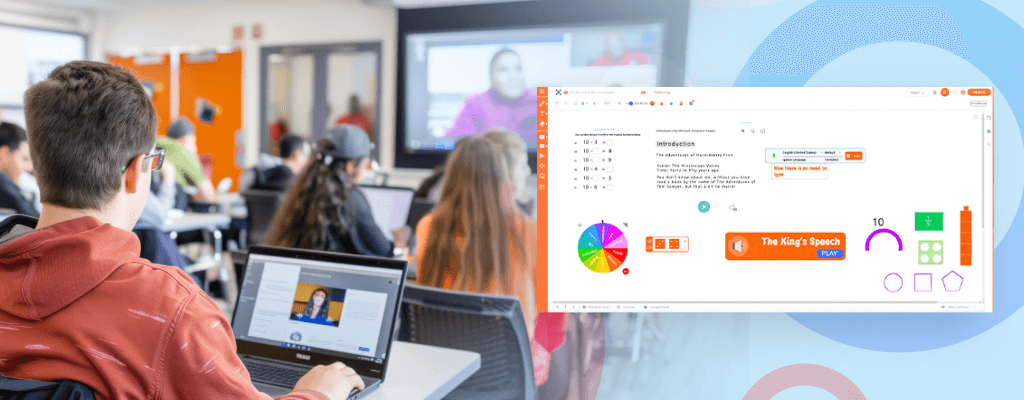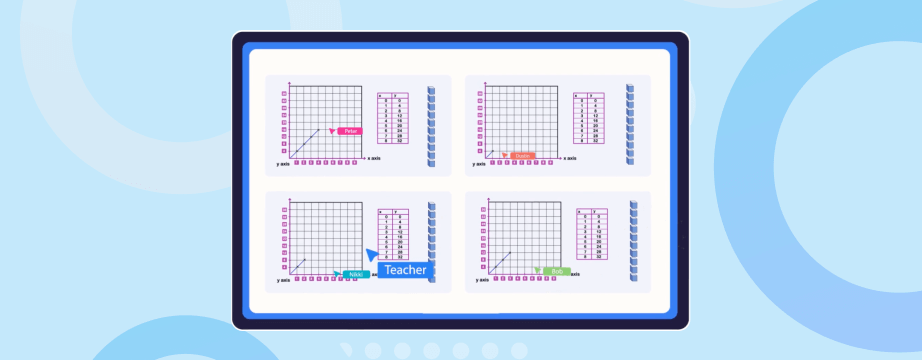Overcoming the Challenges of Hybrid Learning with Online Whiteboards

TABLE OF CONTENTS
Hybrid learning has become an integral part of the modern educational
system, blending traditional in-person instruction with virtual learning
to provide flexibility for both students and teachers. While this model
offers various benefits, it also poses significant
hybrid learning challenges, particularly related to
engagement, workload management, and overall teacher well-being. This
article will explore the
hybrid learning challenges for teachers and how
online whiteboards can help overcome them, ultimately answering the
question: Is hybrid learning effective in addressing
the needs of modern education?
Key Challenges of Hybrid Learning
Hybrid learning, while offering flexibility and diverse learning
opportunities, comes with its own set of obstacles. Below are some of
the primary hybrid learning challenges that teachers
and institutions face when implementing hybrid learning models:
1. Maintaining Student Engagement: Keeping students
engaged in a hybrid learning setup is challenging, as it involves
balancing the needs of both in-person and online learners. Teachers
must manage dual modalities, which can often lead to fragmented
communication and uneven attention distribution. The
hybrid learning challenges for teachers in keeping
students engaged require innovative solutions like real-time
interaction tools.
2. Teacher Workload Management: Managing a hybrid
class requires teachers to prepare lessons that cater to both physical
and virtual attendees, leading to an increased workload. This dual
preparation can be overwhelming and contribute to significant stress.
Finding ways to reduce workload and streamline lesson preparation is
essential to overcoming hybrid learning challenges.
3. Teacher Burnout and Mental Health: The demanding
nature of hybrid teaching can quickly lead to teacher burnout. The
continuous juggling of responsibilities can wear down even the most
experienced teachers, highlighting the need for effective teacher
burnout solutions and ways to prevent teacher burnout. Addressing
hybrid learning challenges for teachers is crucial to
maintaining teacher well-being and preventing mental health issues.
4. Technical Challenges: Balancing various
technological tools and platforms can be cumbersome, both for teachers
and students. Inadequate technology integration often results in
miscommunication and reduced efficiency, making it essential to choose
the right tools to alleviate
hybrid learning challenges.
How Can Online Whiteboards Overcome These Challenges?
Online whiteboards offer dynamic and interactive tools that can
streamline hybrid learning and improve both student engagement and
teacher workload. Here’s how they help overcome the
hybrid learning challenges:
1. Real-Time Interaction and Engagement: Online
whiteboards allow students to collaborate in real-time, regardless of
their location. Teachers can create interactive lessons, add
multimedia elements, and invite students to participate actively by
annotating, drawing, or brainstorming on the shared board. This
real-time interaction addresses the
hybrid learning challenges of student engagement,
making learning more immersive and effective.
2. Simplified Lesson Planning and Delivery: An online
whiteboard centralizes lesson planning and delivery, reducing the
workload associated with preparing separate resources for in-person
and remote learners. Teachers can store, organize, and reuse lesson
templates, making lesson preparation more efficient. This helps in
managing teacher workload and avoiding the stress associated with
creating different sets of materials, mitigating
hybrid learning challenges.
3. Enhanced Teacher-Student Collaboration: Teachers
can collaborate more effectively with students using online
whiteboards. Features like breakout rooms, group workspaces, and
shared project boards foster teamwork and collective problem-solving.
This collaborative environment can serve as a teacher burnout solution
by lightening the instructional load through shared teaching methods,
easing the hybrid learning challenges for teachers.
4. Comprehensive Feedback Mechanisms: Teachers can
provide immediate feedback by marking or commenting directly on
student assignments on the whiteboard. This reduces the need for
additional software and streamlines the assessment process, which is
essential for preventing teacher burnout and addressing the
hybrid learning challenges teachers face in tracking
student progress.
Major Features of Online Whiteboards to Streamline Hybrid Learning

Below are the major features that make these tools indispensable for
modern educational practices, helping to address
hybrid learning challenges:
1. Multi-User Collaboration:
Online whiteboards support multiple users simultaneously, allowing
students and teachers to collaborate in real-time. This feature is
beneficial for group activities, team-based projects, and interactive
learning, providing a solution for the
hybrid learning challenges
of interaction and engagement.
2. Multimedia Integration:
The ability to add images, videos, and documents enriches the learning
experience. Teachers can create more comprehensive lessons that cater to
various learning styles, maintaining student interest and enhancing
understanding, thus mitigating the
hybrid learning challenges
of engagement.
3. Accessibility and Cloud Storage:
Online whiteboards often come with cloud storage options, making it easy
to save, share, and access materials anytime, anywhere. This flexibility
is crucial for
hybrid learning, where resources need to be consistently available to both in-person
and online learners, reducing the technical challenges teachers face.
4. Customizable Templates and Tools:
Teachers can use customizable templates to create lessons tailored to
specific topics or classroom activities. Annotation tools, sticky notes,
and drawing functions make lessons more interactive and help teachers
manage their workload more efficiently, addressing
hybrid learning challenges for teachers.
5. Integration with Video Conferencing Platforms:
Many online whiteboards integrate seamlessly with video conferencing
tools like Zoom, Google Meet, and Microsoft Teams. This ensures that
teachers can conduct lessons smoothly without needing to switch between
platforms, simplifying the teaching process and preventing disruptions
that can cause
hybrid learning challenges.
To Conclude
From boosting student engagement and supporting collaborative learning
to alleviating the stress of dual teaching, online whiteboards can make
hybrid education more manageable and effective. By integrating these
tools, schools can implement ways to avoid teacher burnout and enhance
teacher mental health, while also answering the question:
Is hybrid learning effective? The answer is yes—when
supported by the right tools like online whiteboards.
Whiteboard.chat is one of the best free online whiteboards tailored to
meet the needs of modern hybrid learning. We developed
this platform by incorporating feedback from numerous teachers facing
challenges in online teaching. Our features like real-time language
translation, speech-to-text functionality, and seamless integration with
Google Meet and Microsoft Teams make Whiteboard.chat the top choice for
overcoming hybrid learning challenges for teachers.
Best of all, it provides an accessible and comprehensive solution for
teachers looking to streamline their teaching methods and improve their
classroom experience, proving that
hybrid learning can
be both effective and manageable with the right resources. For teachers
seeking a
whiteboard for online teaching, Whiteboard.chat offers all the necessary features to enhance both
teaching and learning in a hybrid environment.


 Try it Free (No Credit Card)
Try it Free (No Credit Card)